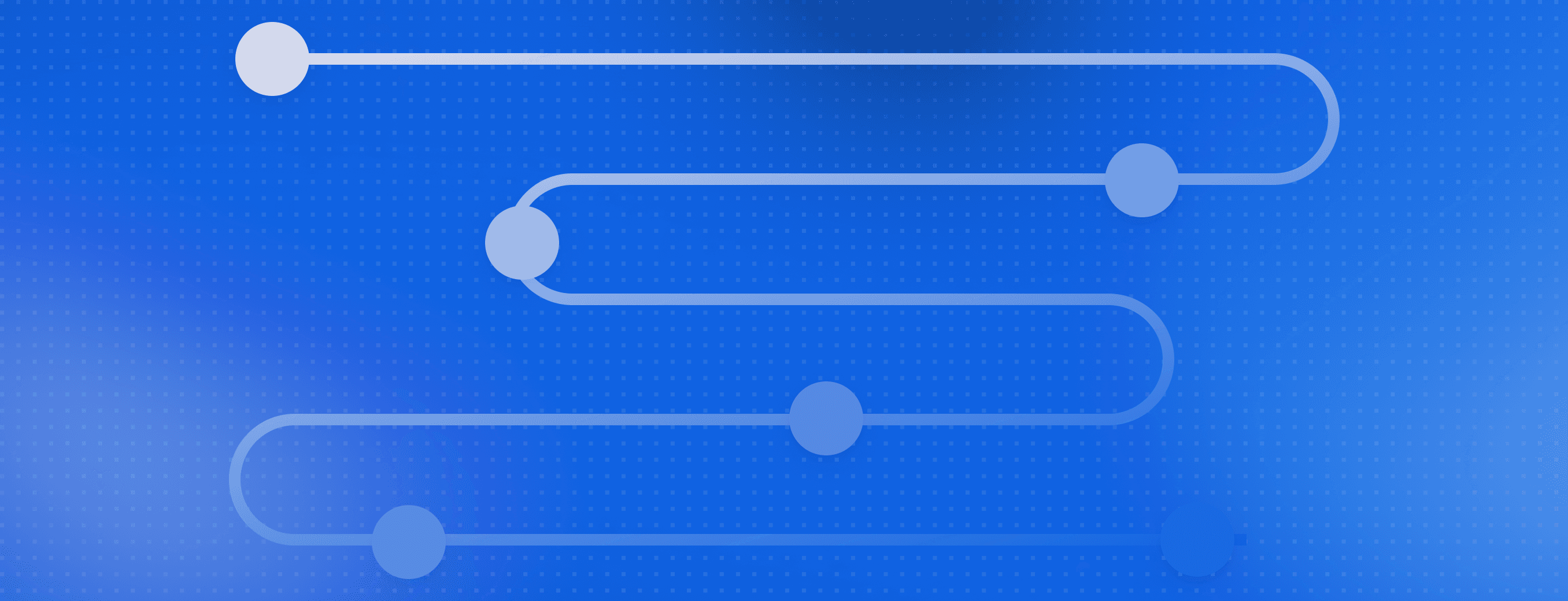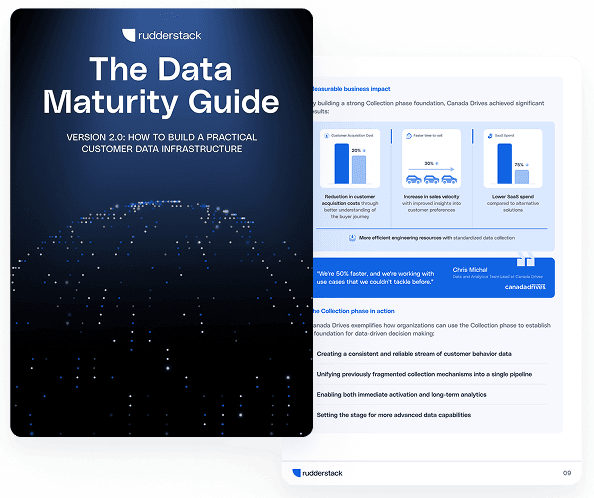AI use cases: Real-world examples of generative AI in action

Imagine a tool that can write, analyze, and even create original images or music in seconds. That's the power behind many of the most exciting AI use cases emerging today, from customer support and content creation to real-time analytics and automation.
With the right approach and solid infrastructure, any team can use AI to streamline operations, enhance personalization, and unlock new capabilities.
In this post, we'll explore real-world AI use cases across functional areas and industries, highlighting how generative models are changing the way companies operate and compete. We'll also discuss how RudderStack helps power these use cases by delivering the clean, real-time customer data that AI systems need to perform reliably and responsibly, without compromising on governance or control.
Main takeaways:
- Generative AI enables high-impact use cases across customer engagement, operations, content creation, and workflow automation by reducing manual effort and unlocking new efficiencies
- Industries like finance, healthcare, e-commerce, and manufacturing use AI for fraud detection, diagnostics, personalization, and predictive maintenance
- AI-driven personalization and automation improve user experiences while driving measurable gains in speed, accuracy, and cost reduction
- Successful AI implementations start with clear business objectives and rely on clean, well-integrated, and compliant data pipelines
- RudderStack delivers the real-time, high-quality data infrastructure needed to power enterprise-grade AI use cases at scale
What are the key functional areas for using generative AI?
Generative AI is reshaping business functions across industries by enabling entirely new ways of working. As organizations integrate generative models into their operations, the potential impact is significant—McKinsey estimates generative AI could contribute up to $4.4 trillion in annual global economic value by 2030.
This value comes not just from automation, but from how generative AI enhances core business capabilities.
Customer engagement
AI can transform how you interact with customers through personalization and automation. Virtual assistants answer questions instantly, while recommendation engines suggest relevant products. Sentiment analysis tools detect patterns in customer feedback to identify improvement areas. Automated messaging campaigns deliver the right content at the right time.
Real-time personalization engines can adjust product recommendations mid-session based on live clickstream data, increasing conversions and reducing bounce rates. Loyalty programs are also evolving; AI can segment users by predicted lifetime value or purchase cadence and tailor rewards accordingly.
- 24/7 support: AI chatbots handle basic inquiries without human intervention
- Personalized experiences: Product recommendations based on browsing history
- Feedback analysis: Automatic categorization of customer comments
Tip: RudderStack enables real-time segmentation and data delivery, ensuring customer engagement tools receive accurate, governed data when it matters most.
Operational efficiency
AI streamlines internal processes by automating repetitive tasks that previously consumed valuable employee time. Demand forecasting algorithms analyze historical sales data, seasonal trends, and market indicators to predict inventory needs with greater accuracy than traditional methods, reducing both stockouts and excess inventory costs.
Intelligent scheduling tools optimize employee shifts based on skill requirements, availability patterns, and workload forecasts, while project management AI adjusts timelines dynamically when dependencies change. Document processing systems extract key information from forms, contracts, and invoices, routing data to appropriate systems without manual intervention.
- Resource optimization: AI allocates staff and materials more efficiently by analyzing real-time usage patterns, reducing waste while maintaining service levels
- Error reduction: Automated quality checks scan thousands of data points per second to catch mistakes before they reach customers, decreasing error rates compared to manual reviews
- Process acceleration: Tasks that took hours of manual effort can be completed in minutes through intelligent automation, with some companies reporting significant productivity gains in routine administrative functions
Creative applications
Content creation becomes faster and more versatile with generative AI tools. Marketers use AI to draft compelling ad copy in seconds, generate custom brand-aligned images without graphic designers, and suggest data-driven social media posts that maximize engagement metrics.
Design teams produce multiple concept variations for A/B testing in minutes rather than days. Video creators use AI to automatically edit raw footage, generate accurate multilingual captions, remove background noise, and even create synthetic voiceovers that match brand guidelines.
- Content scaling: Create dozens of targeted marketing material variations for different channels, demographics, and languages while maintaining brand consistency across all touchpoints
- Ideation support: Generate creative concepts as starting points that overcome creative blocks, with AI suggesting unexpected approaches that human teams can refine and enhance
- Production assistance: Automate technical aspects of creative work like background removal, color correction, layout optimization, and content reformatting for different platforms
RudderStack powers these workflows by delivering accurate, real-time customer traits into creative tools, enabling dynamic content personalization and cross-channel asset targeting.
Workflow automation
AI connects different systems to create end-to-end automated processes. Report generation tools transform raw data into actionable insights without manual effort. Legal teams use AI to summarize documents and identify key clauses. IT departments automate ticket routing and resolution for common issues.
You can also trigger incident alerts based on log anomalies or system performance patterns. In sales workflows, AI models score new leads in real time as CRM fields update, prioritizing outreach instantly.
- Cross-system integration: AI bridges gaps between different business tools
- Knowledge management: Automatic organization of company information
- Process orchestration: Coordinating multiple steps across departments
Ready to build the data foundation for your AI initiatives? Request a demo to see how RudderStack can help you collect, transform, and deliver the quality data your AI systems need.
How are different industries using generative AI?
Each industry adapts AI to address its specific challenges and opportunities. The most innovative AI business use cases appear in finance, healthcare, e-commerce, media, technology, education, and manufacturing sectors.
AI use case examples across industries demonstrate how this technology is creating tangible business value. U.S. private AI investment reached $109.1 billion in 2024, reflecting the growing commitment to scaling these solutions.
These use cases for AI demonstrate how the technology can be tailored to solve industry-specific problems while delivering measurable business value.
Finance
Financial institutions implement AI for fraud detection, risk assessment, and customer service. AI algorithms analyze transaction patterns to identify suspicious activities in real time.
Banks automate loan approvals and credit scoring to make faster lending decisions. Personalized financial advice is delivered through AI-powered interfaces.
- Fraud prevention: Real-time analysis of transaction patterns using neural networks that detect anomalies across billions of data points, reducing false positives while flagging suspicious activities
- Automated underwriting: Faster loan decisions with consistent criteria through models that evaluate 100+ variables simultaneously, cutting approval times while maintaining regulatory compliance
- Investment recommendations: Personalized portfolio suggestions based on risk tolerance, market conditions, and behavioral analysis that outperform generic allocations annually while adapting to changing financial goals
Healthcare
Medical professionals use AI to improve diagnostics, treatment planning, and administrative efficiency. In 2023 alone, 223 AI-enabled medical devices were approved by the FDA, up from just six in 2015. Image analysis algorithms help detect diseases earlier and more accurately.
Patient triage systems prioritize cases based on urgency and available resources. Administrative tasks like scheduling and billing are automated to reduce errors.
- Diagnostic assistance: AI algorithms analyze medical images like X-rays, MRIs, and CT scans to detect abnormalities, flagging potential tumors, fractures, or tissue damage that might be missed in manual review
- Treatment planning: Personalized care recommendations based on comprehensive patient data analysis, including medical history, genetic markers, and treatment response patterns
- Administrative automation: Intelligent systems that streamline paperwork processing, optimize appointment scheduling based on urgency and resource availability, and automate insurance verification, reducing administrative costs while cutting patient wait times
E-commerce
Online retailers leverage AI to personalize shopping experiences and optimize operations. Visual search capabilities let customers find products by uploading images instead of typing descriptions.
Product recommendation engines increase average order values. Inventory management systems predict demand patterns to prevent stockouts.
- Smart search: Finding products through images or natural language queries that understand user intent, with AI systems recognizing objects in customer-uploaded photos and matching them to inventory
- Personalized recommendations: Products suggested based on real-time browsing behavior, purchase history, and similar customer profiles, with algorithms that continuously adapt to seasonal trends and detect micro-segments that traditional analytics might miss
- Dynamic pricing: Automatic price adjustments based on demand patterns, competitor movements, inventory levels, and even weather forecasts. AI systems can optimize margins while maintaining sales velocity, implementing targeted price changes daily that would be impossible to manage manually
Media & entertainment
Content creators use AI for scriptwriting, editing, and audience targeting. Automated tools generate video captions and translate content for global audiences.
Music composition algorithms create background tracks and sound effects. Virtual characters and environments reduce production costs for visual content.
- Content creation: AI-powered tools generate script outlines, dialogue suggestions, and character development ideas that align with genre conventions, while producing visual assets like background environments, special effects, and character models
- Audience targeting: Sophisticated algorithms analyze viewing patterns, engagement metrics, and content preferences across platforms to deliver hyper-personalized recommendations that increase watch time
- Production automation: AI systems handle technical aspects of video production, including color grading, audio normalization, scene transitions, and content reformatting for different platforms, reducing post-production time
Technology
Software companies use AI to accelerate development and improve user experiences. Code generation tools help programmers work more efficiently.
Automated testing identifies bugs before software release. Technical support chatbots resolve common issues without human intervention.
- Code assistance: AI pair programmers analyze code context in real time, suggesting function completions, identifying potential bugs, and recommending optimizations that align with best practices
- Quality assurance: Automated testing frameworks generate thousands of test scenarios based on code changes, simulating edge cases human testers might miss, while identifying regression issues before deployment and providing detailed failure analytics
- User support: Intelligent help systems that learn from each interaction, automatically categorize technical issues, surface relevant documentation, and escalate complex problems to specialized support teams
Education
Educational institutions implement AI to personalize learning and reduce administrative burdens. Two-thirds of countries now offer or plan to offer K–12 computer science education, fueling the next wave of AI talent. Adaptive learning systems adjust content difficulty based on student performance.
Automated grading tools assess assignments consistently. Course creation systems generate quizzes and study materials from existing content.
- Personalized learning: Adaptive systems that analyze student performance patterns across subjects, automatically adjusting difficulty levels and content delivery methods based on comprehension rates and learning styles
- Assessment automation: AI-powered grading tools that evaluate written assignments, code submissions, and multimedia projects using rubric-based analysis, providing consistent scoring with detailed feedback in minutes
- Administrative efficiency: Intelligent systems that optimize class scheduling based on room availability, instructor preferences, and student enrollment patterns, while automating repetitive tasks like transcript processing, attendance tracking, and parent communications
Manufacturing & supply chain
Factories use AI to optimize production and prevent equipment failures. Predictive maintenance systems alert teams before machinery breaks down.
Quality control algorithms inspect products faster than human workers. Supply chain optimization tools adjust to disruptions automatically.
- Predictive maintenance: AI systems analyze thousands of sensor readings to detect subtle equipment anomalies before failures occur, reducing unplanned downtime while extending machine lifespan.
- Quality control: Computer vision systems inspect products at rates exceeding 200 units per minute with near-perfect defect detection accuracy, identifying microscopic flaws invisible to human inspectors
- Supply chain optimization: AI algorithms continuously recalculate optimal inventory levels, transportation routes, and production schedules as conditions change
Build smarter AI pipelines with RudderStack's data infrastructure
To implement AI effectively, organizations must start with clear business objectives and ensure their data infrastructure can support real-time, governed data flow. That means aligning AI initiatives with strategic goals, validating data quality and privacy readiness, and beginning with targeted pilot projects. Measuring outcomes against defined KPIs helps teams scale what works and avoid wasted investment.
Success depends on clean, compliant, and integrated data across systems. Incremental implementation paired with continuous evaluation allows organizations to scale AI use cases with confidence. Whether you're automating workflows, personalizing experiences, or enhancing decision-making, data must be accessible, trustworthy, and aligned with each use case.
RudderStack provides cloud-native customer data infrastructure designed specifically for AI-powered systems. With real-time event streaming, schema validation, and identity resolution, RudderStack helps you deliver high-quality data to your AI systems without creating new silos.
Request a demo to see how RudderStack can streamline your AI journey with trusted, real-time data delivery—and meet us at Booth #F30 at Big Data LDN in September.
Published:
August 7, 2025

Understanding event data: The foundation of your customer journey
Understanding your customers isn't just about knowing who they are—it's about understanding what they do. This is where clean, accurate event data becomes a foundational part of your business strategy.

How AI data integration transforms your data stack
This article breaks down what AI data integration means, explores key benefits like faster time-to-insight and improved data quality, and walks through practical use cases and implementation strategies.

Behavioral segmentation: Examples, benefits, and tools
In this guide, you'll learn how behavioral segmentation works, explore real-world examples, and discover the tools modern teams use to power it. You'll also learn how RudderStack helps unify behavioral data across your entire stack in real time.







